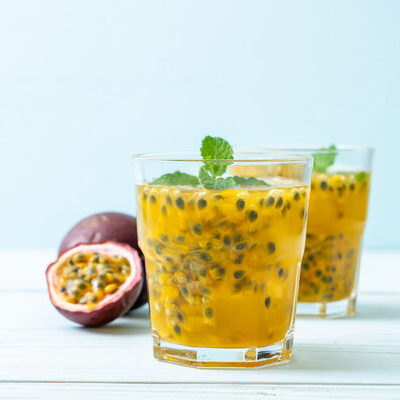
Passion Fruit Juice
What is Passion Fruit Juice?
Passion fruit juice is a beverage made from the passion fruit (Passiflora edulis) of the Passifloraceae family. This juice contains a blend of passion fruit, sugar, and water, providing a tart taste and floral scent. Passion fruit has a small and round shape with firm skin, although the fruit develops wrinkles as it matures and turns to a red or brownish-purple color.
- It has tiny, black, edible seeds with a mustard yellow pulp.
- The two most popular types of this fruit are the purple and yellow varieties.
Five common cultivars of the purple form of passion fruit include:
- Black Knight
- Edgehill
- Frederick
- Kahuna
- Paul Ecke
Origin of passion fruit juice
The purple passion fruit has its origin in subtropical South America, a region covering Southern Brazil to Northern Argentina. The source of the yellow passion fruit is unknown; however, some believe that it originates from Amazonian Brazil. Passion fruit was a common component in the diet of the subtropical South Americans. Spanish missionaries called the flowers of this fruit “flor de las cinco llagas,” which means the flower of the five wounds, because it signified the crucifixion of Christ. This was how the name “passion fruit” came about.
In the 1900s, the purple passion fruit spread throughout the globe. It became valued as a commercial crop in Australia and the continental United States. Yellow passion fruit is also popular in Australia and Venezuela, as it thrives under tropical conditions. Brazil has established industries for the large-scale production of fruit juice. Passion fruit juice is just one of many ways people consume this fruit today.
Functions
Some common uses of passion fruit, apart from making a juice, include:
- It can be utilized as a flavor for cocktails, milkshakes, and ice cream.
- People also include passion fruit in fruit salads.
- The dehydrated form of this fruit’s skin is food for livestock.
Nutrition
In one cup of purple passion fruit juice, there are:

Passion fruit juice contains several nutrients that can nourish the body. Here are some health benefits of this juice:
- It can supply antioxidants that reduce inflammation and cellular stress in the body.
- It is rich in vitamin C, which helps to strengthen the immune system.
- This drink might be capable of reducing stress due to the presence of magnesium.
- It provides a good source of fiber, which helps the digestive system.
- This juice has a low glycemic index. Therefore, it is suitable for diabetic people, as it does not provoke a sharp rise in blood sugar.
This juice is safe and has no severe side effects. However, individuals with a latex allergy might react to passion fruit. If you have a latex allergy, speak to a doctor before drinking this juice.
Commercial production
Passion fruit juice can be produced on a large scale by blending passion fruits and extracting their juice. The preservation of the juice involves the addition of sugar, benzoic acid, and citric acid. Once the juice has been extracted and blended with preservatives, it is bottled and refrigerated until ready to be sold.
The import dollar amount of exotic produce, including passion fruit, rose by 40% in five years to hit $168 million (142 million euros) in 2019. Brazil accounts for the most massive production and consumption of processed and fresh passion fruit. This country is responsible for over 50% of the global production of passion fruit.
Application
Passion fruit juice is easy to make. All you need is passion fruit, water, and sugar. Then, follow the steps below:
- First, cut the fruits and extract their seeds and pulps into a blender.
- Next, add the sugar to the contents of the blender.
- Then, pour the water inside the mixture. Chilled water will be the best option.
- After that, set the blender to a low speed.
- Finally, pour the mixture through a sieve to separate the ground seeds. Keep the juice in the refrigerator till you are ready to consume it.
Ripe passion fruit can last in the refrigerator for about two days. The seeds and pulp of passion fruit can be stored in the freezer for three months. Fresh juice can be kept in the refrigerator for up to three days, although it loses its nutrients over time.
Passion fruit juice recipes
This fruit juice can craft exotic fruit juice blends. Here are some recipes to try:
- Passion Fruit Juice
- Hawaiian Passion Fruit Orange Mango
- Passion Fruit and Pineapple Sangria
- Pineapple, Orange, and Passion Fruit Slushy
- Sparkling Passion Fruit Lemonade
FDA regulation
The Food and Drug Administration classifies passion fruit as a raw agricultural commodity. The organization has its standards for growing, harvesting, and packing this fruit for human consumption. The FDA has also calculated the labeled percentage of passion fruit juice from its concentrate or beverage using Brix levels. The minimum Brix level for 100% passion fruit juice is 14.0 percent.
References
“Passiflora Edulis (Passion Fruit).” Keys.lucidcentral.org, BioNET-EAFRINET, keys.lucidcentral.org/keys/v3/eafrinet/weeds/key/weeds/Media/Html/Passiflora_edulis_(Passion_Fruit).htm.
Nicole, Galan. “Passion Fruit: 8 Benefits and Nutrition.” Medical News Today, MediLexicon International, 6 Feb. 2019, www.medicalnewstoday.com/articles/324383.
“CFR – Code of Federal Regulations Title 21.” accessdata.fda.gov, U.S Food & Drug Administration, 1 Apr. 2019, www.accessdata.fda.gov/scripts/cdrh/cfdocs/cfcfr/CFRSearch.cfm?fr=112.1.
